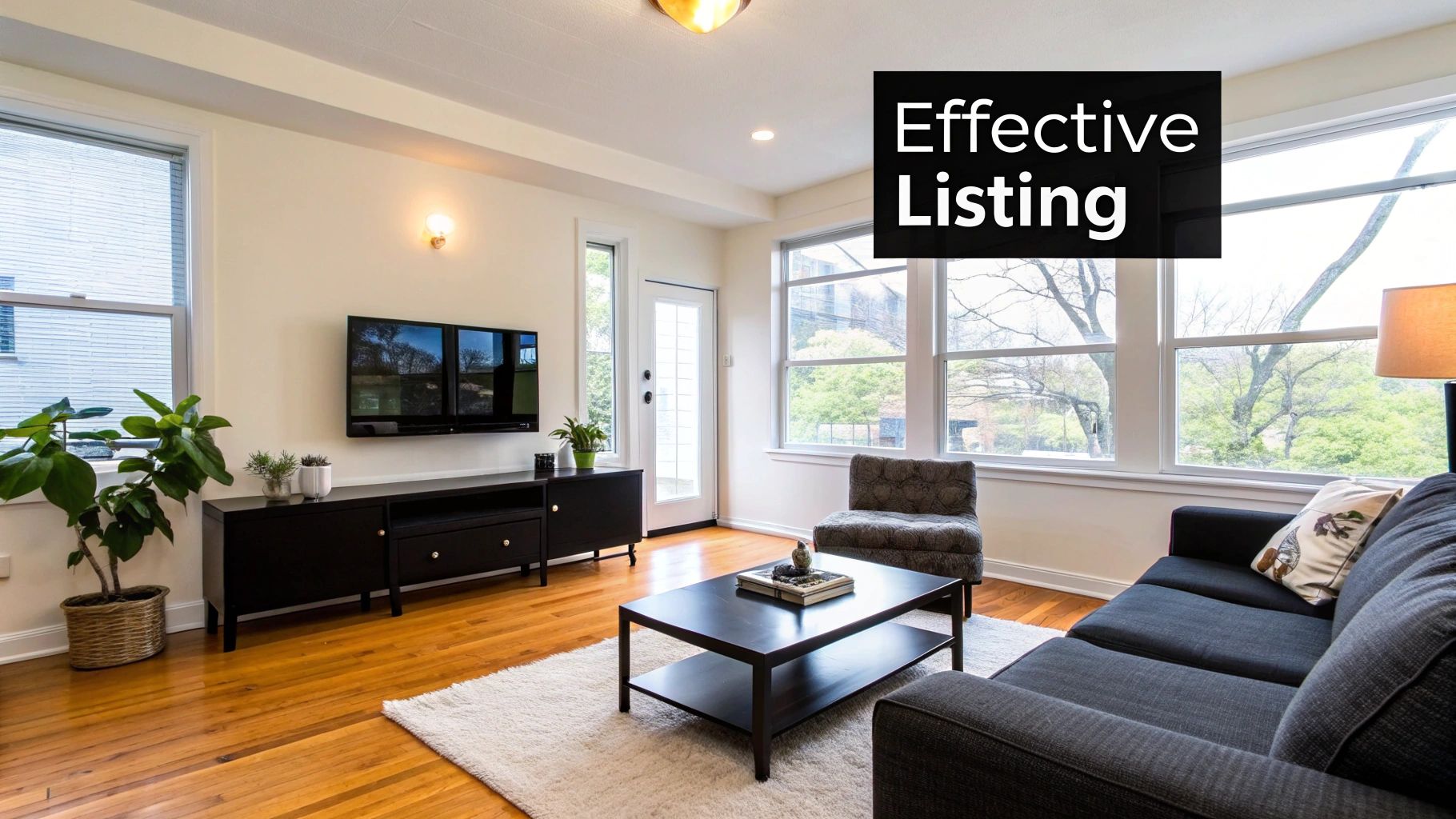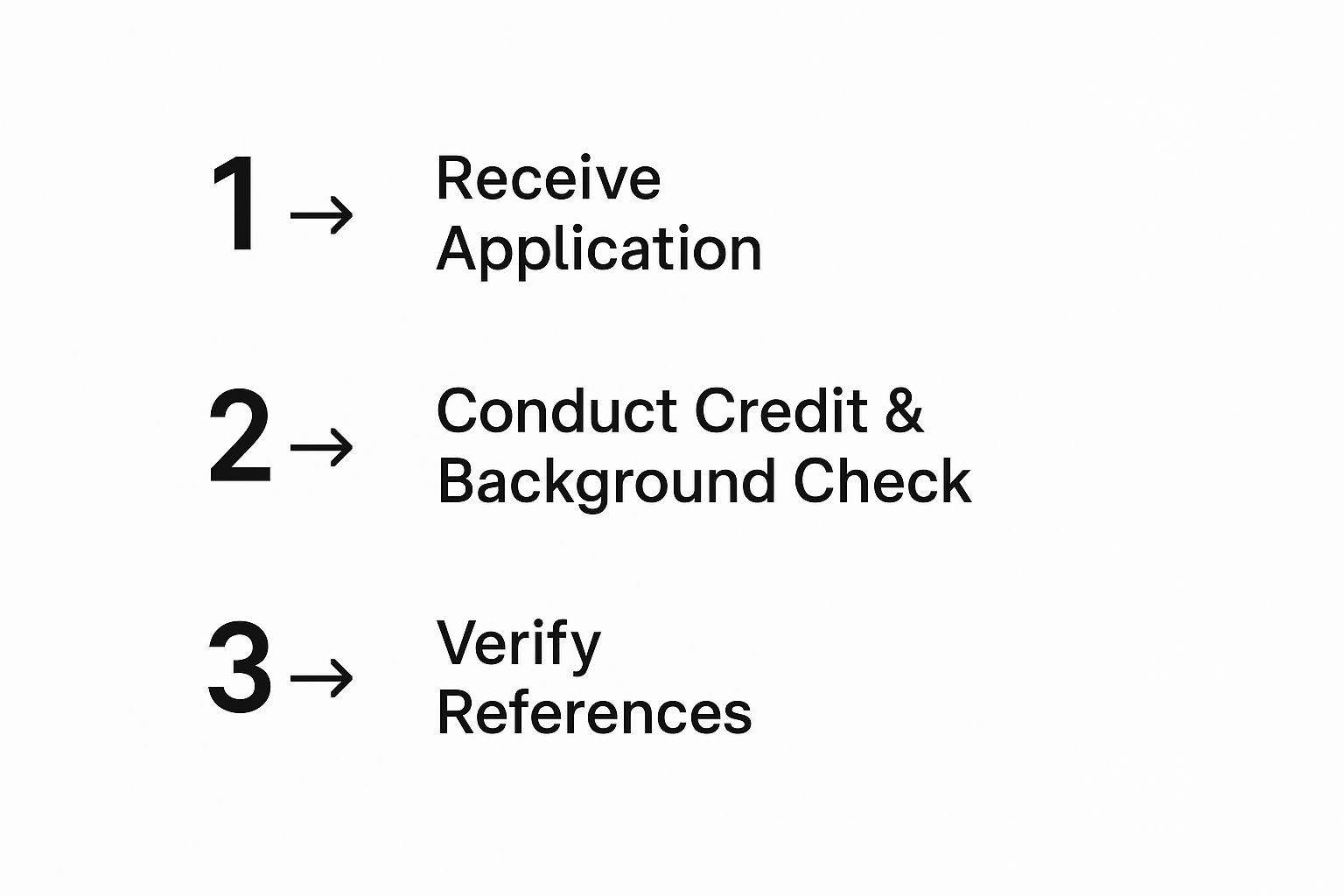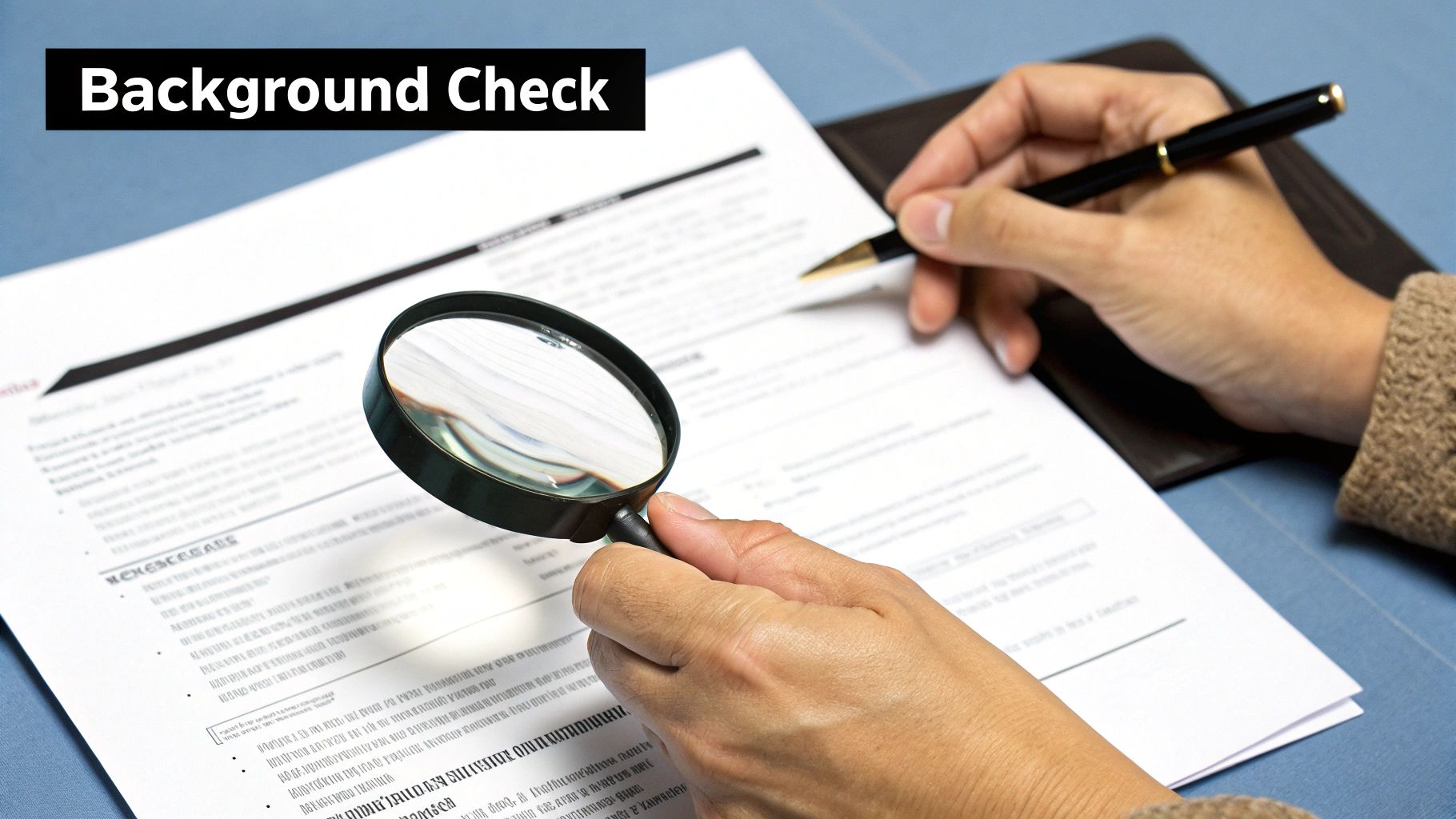How to Find Good Tenants A Landlord's Guide
- Sarah Porter

- Sep 5
- 14 min read
Finding the right tenant is all about proactive preparation, not just reactive screening. The whole game is won or lost before you even post a listing. You have to create an attractive, well-maintained environment that responsible renters are actually looking for, set a smart rental price, and know fair housing laws like the back of your hand.
Putting in this work upfront naturally weeds out applicants you don't want and sends a clear signal that you're a professional landlord who takes things seriously.
Laying the Groundwork to Attract Great Tenants
The hunt for a solid tenant doesn't kick off when your ad goes live. It starts the second your last tenant hands over the keys. The effort you put in during this turnover period directly shapes the quality of people who apply. You need to think of your rental less like a space and more like a product—the best products always attract the best customers.
Before you even think about snapping photos, your top priority is to make the property immaculate. I’m talking about more than just a quick wipe-down. You have to fix all those little things that discerning renters notice immediately: the dripping faucet, the door that sticks, the scuff marks on the baseboards.
A fresh coat of neutral paint is one of the highest-return investments you can make; it instantly makes a space feel brighter and newer. Small upgrades can also have a huge impact. Think about swapping out dated light fixtures or old cabinet pulls—these little touches can significantly boost the perceived value for a very small cost.
Set a Competitive and Informed Rental Price
Pricing your rental is a balancing act. If you aim too high, you’ll scare off the best applicants and the property will sit empty, costing you money every day. Price it too low, and you’re just leaving cash on the table each month. The only way to get it right is to use real data.
Start by digging into the "comps"—comparable properties—right in your immediate area. You're looking for rentals with a similar:
Square footage and layout
Number of bedrooms and bathrooms
Amenities (like in-unit laundry, parking, or a balcony)
Overall condition and age
Tools on sites like Zillow have become essential for landlords, giving you a clear picture of local market trends.

Using data like this helps you nail down a price that’s both competitive enough to attract applicants and profitable for your business.
Understand Fair Housing Laws
This last part is non-negotiable: you absolutely must understand and follow fair housing laws. These federal and state regulations are in place to prevent discrimination based on protected classes like race, religion, sex, familial status, or disability.
Following the law isn't just about avoiding a lawsuit; it's about being a professional. The best tenants want to rent from landlords who are fair and ethical. When you follow these guidelines from the very start—in your advertising, during showings, and throughout your screening process—you build a foundation of trust. For a deeper dive, check out our guide on the https://www.mypropertymanaged.com/post/top-tips-for-landlords-how-to-attract-and-retain-quality-tenants.
Creating a Rental Listing That Gets Noticed

Alright, your property is sparkling clean and you've landed on the perfect rental price. Now comes the fun part: creating an online listing that stops renters in their tracks. Think of your rental ad as more than just a "for rent" sign—it's your first line of defense, designed to attract the reliable, responsible tenants you want and gently weed out those who aren't the right fit.
Getting this right means nailing two things: fantastic photos and compelling, honest ad copy.
The photos are, without a doubt, the most important piece of the puzzle. Great photos can make your phone ring off the hook. Bad ones will leave you with nothing but crickets. You don’t need to hire a professional photographer; your smartphone can do an amazing job if you just follow a few ground rules.
Let the Light In: Before you take a single picture, open every blind and flip on every light switch. Bright, well-lit photos feel welcoming and spacious. Dark, gloomy pictures just look sad.
Show Off the Good Stuff: Does your kitchen have brand-new stainless steel appliances? Is there a stunning view from the living room window? Make those shots the headliners of your listing.
Clean, Then Clean Again: I can't stress this enough—declutter everything. Clear off countertops, put away personal items, and make sure the space is spotless. Potential tenants need to be able to envision their own belongings in the space, not yours.
Want to really stand out? Shoot a quick video walkthrough. A simple 60-second tour on your phone can build a massive amount of trust and give people a real sense of the property's layout that photos alone just can't capture.
Crafting Compelling Ad Copy
Once the visuals have hooked them, your words need to reel them in. Your goal is to sell the lifestyle the property offers, not just list its features. Anyone can say "2 bed, 2 bath." That doesn't tell a story.
Think about the difference. A generic ad might say: "Nice apartment with a balcony."
A much better version sounds like this: "Start your mornings with coffee on a private balcony overlooking a quiet, tree-lined street. This spacious two-bedroom is the perfect retreat after a long day." See the difference? One is a fact, the other creates an emotional connection. This is how you attract tenants who will appreciate and care for the peaceful environment you're offering.
Pro Tip: Specificity is your best friend. Mention the school district by name, the walking distance to the nearest coffee shop, or the nearby parks and trails. Being upfront with these details saves everyone time and brings in serious applicants who already know your neighborhood is where they want to be.
Where to Post Your Listing for Maximum Reach
To get your property in front of the right people, you need a smart distribution strategy. Start with the heavy hitters. Posting on major platforms like Zillow, Realtor.com, and Apartments.com is non-negotiable. They syndicate your listing across dozens of smaller sites, giving you incredible reach with minimal effort.
But don't stop there. Some of my best tenants have come from hyper-local sources. Post your listing in neighborhood-specific Facebook groups, on Nextdoor, or even on local community message boards. These channels connect you with people actively looking to move into your specific area, which often means you get higher-quality, more committed applicants.
A mix of broad-reach platforms and targeted local advertising is the winning formula for filling your vacancy quickly with a fantastic tenant.
Mastering the Tenant Screening Process
The moment applications start rolling in, your job shifts from marketer to investigator. This is, without a doubt, the most important phase of finding a great tenant. A thorough, consistent screening process is your single best defense against the headaches every landlord dreads—late rent, property damage, and the nightmare of eviction. This isn't about a gut feeling; it's about making a smart business decision based on facts.
It all starts with a rock-solid rental application. This isn't the place to use a generic, one-page template. Your application needs to gather all the critical details: employment history, verifiable income, previous addresses, and solid references. Most importantly, it must include a clear, written authorization from the applicant allowing you to run credit, criminal background, and eviction checks. Without that consent, you can't move forward.
The image below lays out the typical flow of a well-structured screening process, from that initial application to the final reference checks.

As you can see, it’s a journey. You’re building a complete picture of each applicant, piece by piece, to ensure you’re making the right choice for your property.
Digging into the Data
Thankfully, landlords today have incredible tools at their disposal. Using professional tenant screening services has gone from a "nice-to-have" to an absolute necessity. The global market for these services was valued at around USD 1.76 billion and is growing fast, which tells you just how essential this step has become for landlords everywhere.
These services pull together all the crucial information into one easy-to-read report, giving you a clear window into an applicant's past.
Credit Report: Don’t just glance at the three-digit score. Look deeper. Are there patterns of late payments? Significant debts in collections? A consistent history of paying bills on time is one of the best predictors of a tenant who will pay rent on time.
Criminal Background Check: It's vital to review this report while staying compliant with all fair housing laws. You're looking for convictions that could genuinely threaten the safety of the property or neighbors, not minor issues from a decade ago.
Eviction History: This is a huge red flag. A prior eviction is a direct indicator of a tenant failing to uphold their end of a lease agreement. It’s one of the most critical data points you'll see.
Pro Tip: Before you even look at a single application, write down your screening criteria. For example, you might decide on a minimum credit score of 650 or an income-to-rent ratio of 3:1. The key is to apply these exact same standards to every single person who applies. This keeps you fair, consistent, and legally compliant.
To help you stay organized and consistent, I've put together a simple checklist.
Your Tenant Screening Checklist
Use this checklist to ensure you perform a comprehensive and fair evaluation for every rental applicant.
Screening Component | What to Look For | Why It's Important |
|---|---|---|
Completed Application | All fields filled out, signed consent for checks | Shows seriousness and provides necessary authorization. |
Credit Report | Score, payment history, debt load, collections | Indicates financial responsibility and ability to pay rent. |
Criminal History | Relevant convictions (per Fair Housing laws) | Assesses potential risk to the property and other tenants. |
Eviction History | Any prior eviction filings or judgments | A major red flag for non-payment or lease violations. |
Income Verification | Pay stubs, tax returns, or offer letters | Confirms the applicant can genuinely afford the rent. |
Landlord References | Payment history, property care, neighbor relations | Provides a real-world account of their behavior as a tenant. |
Following a consistent checklist like this not only protects your investment but also ensures you're treating every applicant fairly under the law.
Verifying Income and Checking References
A screening report gives you the hard data, but you still need to verify it. Never, ever take an applicant's stated income at face value. Always ask for proof—recent pay stubs, a signed offer letter for a new job, or the last couple of tax returns. This simple step can prevent the vast majority of future rent payment problems.
Finally, it's time to pick up the phone and call their past landlords. This is your chance to get a candid look at what this person is really like as a renter. Go beyond just asking, "Did they pay on time?"
Did they provide proper notice before they left?
Were there ever any complaints from the neighbors?
How did they leave the unit? Did they get their full security deposit back?
Would you rent to them again?
That last question is the most telling one you can ask. A moment of hesitation or a flat "no" speaks volumes. By combining the hard data from reports with verified, real-world accounts, you build a 360-degree view of your applicant. This methodical approach is how you master the screening game and find someone who will treat your property with respect.
For a deeper dive, check out our complete guide on tenant screening services.
Conducting Productive Showings and Interviews

A pristine screening report tells you the facts, but the in-person meeting reveals the full story. This is where you get to see beyond the numbers and get a real feel for the person who wants to live in your property. A successful showing is part tour, part informal interview—it's your chance to see if they're a good fit, and their chance to decide if they love the place.
To make the most of everyone’s time, I've found it's best to group individual showings back-to-back or even host a short open house. It’s efficient for you and often creates a healthy sense of demand. Come prepared to talk about more than just the unit itself. Be ready for questions about the neighborhood, average utility costs, and your approach to maintenance. A landlord who knows their stuff makes a great first impression.
Asking the Right Questions
You absolutely have to follow fair housing laws and steer clear of any personal questions. That doesn't mean you can't learn what you need to know. The goal is to get a sense of their responsibility and how they communicate through a casual, business-focused chat.
Here are a few legally-sound questions I like to weave into the conversation:
"So, what are you hoping to find in your next rental home?"
"What's your ideal move-in date?"
"What's prompting you to move from your current place?"
"Do you have any questions for me about the lease or the property rules?"
Their answers are often very revealing. Someone who goes on and on complaining about their last landlord might be a problem, whereas a person who asks smart questions about maintenance procedures is probably on top of things.
Watching for Subtle Red Flags
This is where your experience and observation skills really come into play. Pay close attention to how potential tenants act during the showing. It's not about any single thing, but a collection of small behaviors can paint a pretty clear picture.
Your intuition is a powerful tool here. Remember, you're not just filling a vacancy; you're starting a business relationship. The in-person meeting helps you gauge if that relationship will be built on mutual respect.
Keep an eye out for these subtle warning signs:
Punctuality: Things happen, but arriving significantly late without a quick call or text can show a lack of respect for your time.
Evasiveness: If they're cagey when you ask simple questions about why they're moving, it could mean they have something to hide.
Unrealistic Demands: Be cautious with applicants who start asking for a long list of changes or exceptions to the rules before they've even signed a lease.
Poor Communication: How do they talk to you and anyone they brought along? Disrespectful or overly critical language is a major red flag.
When you combine these real-world observations with the hard data from your screening report, you get a complete picture. It's this comprehensive view that helps you pick a reliable tenant who will pay on time and treat your property with care.
Signing the Lease: How to Protect Your Investment
You’ve navigated the marketing, showings, and screening process, and now you have a great applicant ready to move in. This final stage is what it’s all been building up to, and it’s arguably the most important for your long-term success as a landlord: getting a rock-solid lease agreement signed.
Don't think of the lease as just another piece of paperwork. It’s the legal foundation of your entire rental business. A well-written lease protects your property, clearly lays out the rules of the road for your tenants, and gives you a clear process to follow if things ever go sideways. Flying without a detailed, legally compliant lease is just asking for trouble.
What Every Ironclad Lease Needs
A good lease leaves absolutely no room for gray areas or "I thought you meant..." conversations. While grabbing a generic template online is tempting, it’s a risky shortcut. Those one-size-fits-all documents often skip over crucial details specific to your property or, even worse, might not comply with your local landlord-tenant laws.
Make sure your lease spells out these essentials in plain English:
Rent Payments: Be crystal clear. State the exact dollar amount, the due date (e.g., the 1st of every month), and exactly how you’ll accept payment. You also need to detail your grace period, if you offer one, and the specific late fee that kicks in if the rent isn't on time.
Security Deposit: Disclose the full security deposit amount and list the specific conditions that would lead to deductions. Critically, you must also state the timeline for returning the deposit after the tenant moves out, making sure it aligns perfectly with state and local laws.
Occupants vs. Guests: Name every single adult who is authorized to live in the unit. Then, define your guest policy. How long can a visitor stay before they're considered an unauthorized tenant? A week? 14 days? Spell it out.
Maintenance & Repairs: Create a clear division of labor. Who handles small stuff like replacing lightbulbs? Who handles major appliance repairs? Give them a clear, written procedure for how to submit a maintenance request.
A well-crafted lease is your best defense against future conflicts. It turns potential "he said, she said" arguments into simple, black-and-white agreements. It’s the single most powerful tool you have.
Landlording Isn't What It Used to Be
The way we manage properties and secure tenants has changed dramatically. Not long ago, everything was done with paper applications and manual background checks. Today, the tools at our disposal are infinitely more powerful. The market for tenant screening services is a perfect example, and it’s projected to nearly double in size over the next decade as more landlords demand better data. This shift applies to lease management, too, with digital signatures and online portals making the whole process faster and more secure.
Getting It Signed and Sealed
Once your lease is drafted and ready, the last few steps are all about communication and documentation.
Set aside time to go over the entire document with your new tenant. Do it in person or over a video call, whatever works best. This is their chance to ask questions and your chance to make sure they understand their obligations before they sign on the dotted line. It builds trust and prevents future confusion.
If you need a solid starting point, you can **download our rental lease agreement template** which covers all these critical clauses.
Finally, before you even think about handing over the keys, conduct a move-in inspection together. Use a detailed property condition checklist and walk through every room, noting any scuffs, scratches, or pre-existing issues. Take photos. Once you're both done, you and the tenant should sign the report. This creates a documented baseline of the property’s condition, and it's your absolute best friend when it comes to fairly handling the security deposit at move-out.
Common Questions Landlords Ask
No matter how airtight your process is, you're going to have questions. Picking the right tenant can feel like navigating a maze, but the good news is, most landlords run into the same handful of problems. Let's walk through the most common ones I hear so you can handle them like a pro.
What's the Single Most Important Part of Finding a Good Tenant?
If I had to pick just one thing, it’s having a rock-solid, consistent tenant screening process. This is your best defense against future problems. It’s not just about pulling a credit report; it's about doing the full works—credit, criminal background, and eviction history—for every single adult applicant, every single time. No exceptions.
And don't just take the application at face value. You need to verify their income and actually get on the phone with their past landlords. That's how you get the full picture of who they are as a tenant. Think of diligent screening not as a suggestion, but as your best protection against late rent, damaged property, and the nightmare of eviction.
How Can I Legally Reject a Rental Application?
You can absolutely deny an applicant, but it has to be for a legitimate business reason, not a discriminatory one.
Here are some perfectly valid reasons to say "no":
Their credit score doesn't meet the minimum you’ve set.
They don't make enough money (a good rule of thumb is an income below three times the rent).
You received a bad reference from a previous landlord or their employer.
They have an eviction on their record.
Their criminal history includes something that could genuinely put the property or other tenants at risk.
The secret is to decide on your qualifying criteria before you even list the property, write it down, and apply it fairly to everyone. You can't deny someone because of their race, religion, family status, or any other protected class. That's where you get into serious legal trouble.
Should I Let Tenants Have Pets?
This is a classic landlord dilemma, and it’s a business decision, plain and simple. Going with a strict "no pets" rule is definitely easier. Less wear and tear, fewer potential complaints. But you have to realize you're immediately shrinking your applicant pool in a big way—over 70% of households have a pet.
On the flip side, allowing pets can bring in a flood of great applicants, get your place rented faster, and often lets you charge a bit more in rent or collect a pet fee. If you go this route, you need a crystal-clear pet policy in your lease. Spell out any rules on size, breed, or the number of pets allowed. One more thing: call your insurance agent to check for any breed restrictions on your policy, and don't be afraid to ask for a "pet reference" from their last landlord.
How Much Should I Charge for the Security Deposit?
The gold standard in most places is a deposit equal to one month's rent. But before you put that number in your ad, you absolutely must check your local and state laws. Many areas cap the maximum amount you can legally charge.
A larger deposit gives you a better cushion against potential damages, but if you set it too high, you might scare off some fantastic, well-qualified tenants who can't pull that much cash together at once. It’s a balancing act.
You don't have to figure all this out on your own. At Keshman Property Management, we bring 20 years of real-world experience to the table, making your investment work for you, not the other way around. See how our straightforward, expert approach can help you find and keep great tenants.

Comments